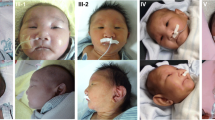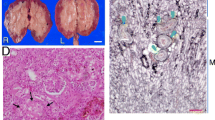Abstract
We present three children with congenital nephrotic syndrome and previously undescribed facial features. These include: (1) small mouth (intercommissural distance mouth (intercommissural distance <3rd percentile); (2) tented upper lip; (3) small nose (interalar distance −2 SD below mean); (4) fullness of cheeks giving a ‘jowly’ appearance; (5) overhanging outer thirds of upper eyelids. These features may reflect prolonged tissue oedema and protein malnutrition in utero and early life.
Conclusion
Characteristic facial features in congenital nephrotic syndrome may reflect intra-uterine malnutrition.
Similar content being viewed by others
References
Rapola J (1987) Congenital nephrotic syndrome. Pediatr Nephrol 1:441–446
Hallman N, Hjelt L, Ahvenainen E (1956) Nephrotic syndrome in newborn and young infants. Ann Pediatr Fenn 2:227–241
Morgan G, Postlethwaite R, Lendon M, et al (1981) Postural deformities in congential nephrotic syndrome. Arch Dis Child 959–962
Hall JJ, Frosten-Iskenius U, Allanson J (1989) Handbook of normal physical measurements. Oxford Medical Publications, Oxford
Author information
Authors and Affiliations
Rights and permissions
About this article
Cite this article
Barrett, T.G., Taylor, C.M. & Milford, D.V. Characteristic phenotype in congenital nephrotic syndrome. Eur J Pediatr 154, 239–240 (1995). https://doi.org/10.1007/BF01954281
Received:
Accepted:
Issue Date:
DOI: https://doi.org/10.1007/BF01954281




